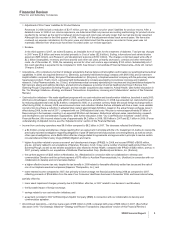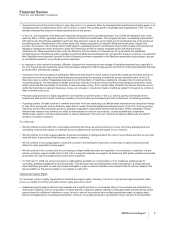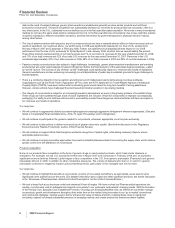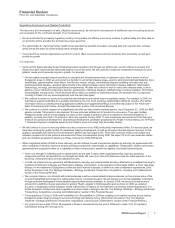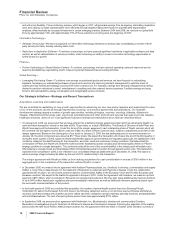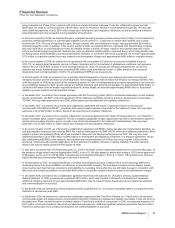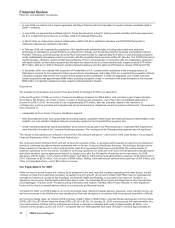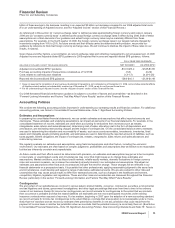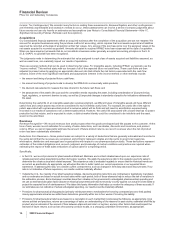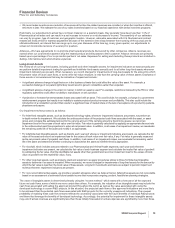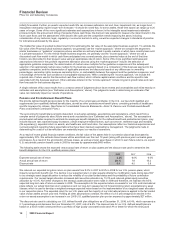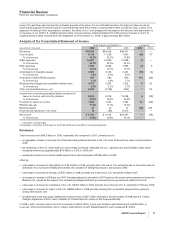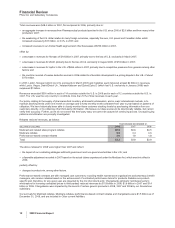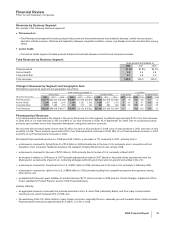Pfizer 2008 Annual Report Download - page 15
Download and view the complete annual report
Please find page 15 of the 2008 Pfizer annual report below. You can navigate through the pages in the report by either clicking on the pages listed below, or by using the keyword search tool below to find specific information within the annual report.
Financial Review
Pfizer Inc and Subsidiary Companies
billion of these savings in the business, resulting in an expected $2 billion net decrease compared to our 2008 adjusted total costs.
(For an understanding of Adjusted income, see the “Adjusted Income” section of this Financial Review.)
As referenced in this section: (i) “current exchange rates” is defined as rates approximating foreign currency spot rates in January
2009 and (ii) “constant currency basis” is defined as the actual foreign currency exchange rates in effect during 2008. Both of these
assumptions are critical elements of our guidance and actual foreign currency rates may be materially different from these
assumptions. For example, in the fourth quarter of 2008, the foreign currency exchange rates in our largest markets changed by
increments ranging from 10% to 25%. As future events and their effects cannot be determined with precision, we provide our
guidance by reference to historical foreign currency exchange rates. We will continue to disclose the impact of these rates on our
results, if material.
Given these and other factors, a reconciliation, at current exchange rates and reflecting management’s current assessment, of 2009
Adjusted income and Adjusted diluted EPS guidance to 2009 reported Net income and reported diluted EPS guidance, follows:
FULL-YEAR 2009 GUIDANCE
(BILLIONS OF DOLLARS, EXCEPT PER-SHARE AMOUNTS) NET INCOME(a) DILUTED EPS(a)
Adjusted income/diluted EPS(b) guidance ∼$12.5-$13.2 ∼$1.85-$1.95
Purchase accounting impacts of transactions completed as of 12/31/08 (1.8) (0.26)
Costs related to cost-reduction initiatives (1.3-1.7) (0.20-0.25)
Reported Net income/diluted EPS guidance ∼$9.0-$10.1 ∼$1.34-$1.49
(a) Does not assume the completion of any business-development transactions not completed as of December 31, 2008, and excludes potential effects
of litigation-related matters not substantially resolved as of December 31, 2008, as we do not forecast those items.
(b) For an understanding of Adjusted income, see the “Adjusted Income” section of this Financial Review.
Our 2009 forecasted financial performance guidance is subject to a number of factors and uncertainties—as described in the
“Forward-Looking Information and Factors That May Affect Future Results” section of this Financial Review.
Accounting Policies
We consider the following accounting policies important in understanding our operating results and financial condition. For additional
accounting policies, see Notes to Consolidated Financial Statements—Note 1. Significant Accounting Policies.
Estimates and Assumptions
In preparing the consolidated financial statements, we use certain estimates and assumptions that affect reported amounts and
disclosures. These estimates and underlying assumptions can impact all elements of our financial statements. For example, in the
consolidated statement of income, estimates are used when accounting for deductions from revenues (such as rebates,
chargebacks, sales returns and sales allowances), determining cost of sales, allocating cost in the form of depreciation and
amortization, and estimating restructuring charges and the impact of contingencies. On the consolidated balance sheet, estimates
are used in determining the valuation and recoverability of assets, such as accounts receivables, investments, inventories, fixed
assets and intangible assets (including goodwill), and estimates are used in determining the reported amounts of liabilities, such as
taxes payable, benefit obligations, the impact of contingencies, rebates, chargebacks, sales returns and sales allowances and
restructuring reserves.
We regularly evaluate our estimates and assumptions, using historical experience and other factors, including the economic
environment. Our estimates are often based on complex judgments, probabilities and assumptions that we believe to be reasonable
but that are inherently uncertain and unpredictable.
As future events and their effects cannot be determined with precision, our estimates and assumptions may prove to be incomplete
or inaccurate, or unanticipated events and circumstances may occur that might cause us to change those estimates and
assumptions. Market conditions, such as illiquid credit markets, volatile equity markets, dramatic fluctuations in foreign currency
rates and economic recession, can increase the uncertainty already inherent in our estimates and assumptions. We adjust our
estimates and assumptions when facts and circumstances indicate the need for change. Those changes will be reflected in our
financial statements on a prospective basis. It is possible that other professionals, applying reasonable judgment to the same facts
and circumstances, could develop and support a range of alternative estimated amounts. We are also subject to other risks and
uncertainties that may cause actual results to differ from estimated amounts, such as changes in the healthcare environment,
competition, litigation, legislation and regulations. These and other risks and uncertainties are discussed throughout this Financial
Review, particularly in the section “Forward-Looking Information and Factors That May Affect Future Results.”
Contingencies
We and certain of our subsidiaries are involved in various patent, product liability, consumer, commercial, securities, environmental
and tax litigations and claims; government investigations; and other legal proceedings that arise from time to time in the ordinary
course of our business. Except for income tax contingencies, we record accruals for contingencies to the extent that we conclude
their occurrence is probable and that the related liabilities are estimable and we record anticipated recoveries under existing
insurance contracts when assured of recovery. For tax matters, beginning in 2007 upon the adoption of a new accounting standard,
we record accruals for income tax contingencies to the extent that we conclude that a tax position is not sustainable under a ‘more-
likely-than-not’ standard and we record our estimate of the potential tax benefits in one tax jurisdiction that could result from the
payment of income taxes in another tax jurisdiction when we conclude that the potential recovery is more likely than not. (See Notes
to Consolidated Financial Statements—Note 1B. Significant Accounting Policies: New Accounting Standards and Note 7E. Taxes on
2008 Financial Report 13


